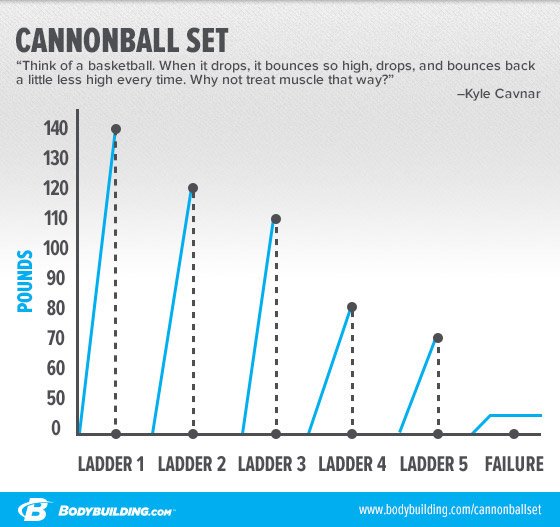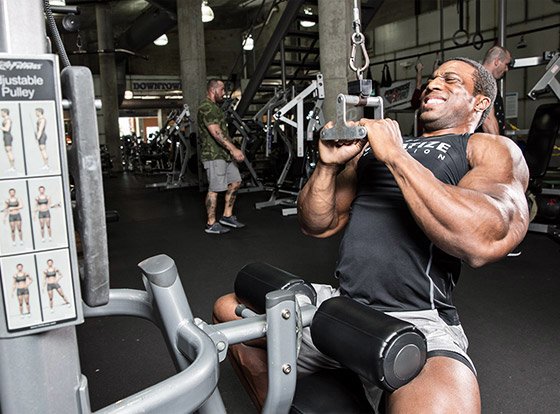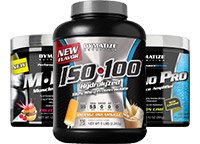Who says that heavy compound movements like squats are the only ones that can make you feel like you're about to lose your lunch? Give trainer Kyle Cavnar just 3-4 minutes and any machine or cable stack, and he'll make you curse the day you were born—in a good way, of course.
"Cannonball" sets are the type of technique that is the calling card of bodybuilders and trainers on the true edge of masochism. To make it through them, you have to truly buy in to the idea that the toughest reps are where gains are earned.
This unique take on the dropset is the brainchild of Cavnar, a trainer at Destination Gym in Dallas, who recently shared them with his friend and Dymatize-sponsored athlete Lawrence Ballenger.
Consider yourself warned.
Leg Extentions Cannonball Set Powered By Dymatize And Bodybuilding.com
Watch The Video - 08:18
LOADING THE CANNON
Cannonball sets can be performed either at the beginning of your workout as a pre-exhaust for a particular body part, or at the end of your workout session as a finishing move. The latter option will make more sense for most people, because you might have trouble doing anything else with whatever muscle you subject to this gauntlet.
Here's how you do it: Start with a light weight, say 50 pounds, and lift it for 8 reps. Easy enough, right? Then, without resting, increase the weight in the smallest possible increment, kind of like you're doing a reverse dropset. So, after 50 pounds is 60 pounds for 8 reps, then 70 pounds for 8 reps, and so on.
Cavnar suggests that you use a fairly long range of motion, but it doesn't have to be perfect all the way up and down. Somewhere around 90 percent suffices. Nor does it have to be quite as controlled as a "normal" rep. About a second up and a second down is perfect.
Once you can no longer do 6-8 decent reps, it's time to—no, not stop—but start back all over again. Re-insert the pin at 50 pounds and repeat the entire process, going up in 10-pound increments as high on the weight stack as you can. Because you're more fatigued this time through, don't expect to make it as far.

Keep adding weight in 10-pound increments until you once again can no longer do 6-8 decent reps. That's your cue to once again begin the process back at 50 pounds. There are no formal rest periods built into the cannonball scheme, but 5 or 10 seconds rests are certainly within reason as long as you keep moving.
When is the cannonball complete? Once you can't do 6-8 reps with the starting weight. That may entail 4-5 rounds, but by the end, Cavnar promises that 50 pounds will feel like 500.
BENEFITS OF CANNONBALLS

Project Mass: Jake Wilson's 14-Week Muscle-Building Trainer
Project Mass is a cutting-edge training, nutrition, and supplement program designed to help you build maximum size. This is how you grow.
So what benefits does a single high-rep set of over 100 reps have? If you watched Dr. Jacob Wilson's Mass Class Training: The Fundamentals of Muscle Growth, or checked out the Project Mass 14-week muscle-building trainer that Ballenger and Wilson recently launched, you know that muscle growth is spurred by multiple mechanisms. These include:
- Cell swelling, or "the pump"
- Mechanical tension through heavy weight
- Muscle damage
- Metabolic damage through acid buildup
A cannonball set will push the first and fourth mechanisms to the max. It will pump the muscle with fluids, stretch the muscle fascia, and create an acidic environment that Ballenger described as feeling "like little red ants just biting every fiber in your thighs."
To make the most of overall growth, you'll need to hit the other mechanisms, too. So don't use this as your only lift of the day. As mentioned earlier, it's best as either a finishing move, or as a pre-exhaust technique to highly fatigue a target muscle at the start of your workout.
NOT JUST FOR LEG DAY
Kavnar says he has used cannonball sets for a wide range of single-joint movements including biceps curls, triceps push-downs, lateral raises, and the pec deck fly. More critical than the muscle you work is the implement you use.

Choose a machine or cable-based movement so you don't have to focus on holding form when your tired muscles beg to quit, and so the weight can be easily changed.
Movements which require plate changes or hunting down dumbbells simply demand too much time between sets. Even if you use a machine or cable stack, it will probably be helpful to have a partner handy to move the pin when things get intense.
Go try this tonight and let us know about your personal success—and muscle failure—in the comments. We promise this will be one of the most challenging techniques you've ever tried!
Recommended For You

Jennifer Dawn's 7 Laws Of The Fit Life
When you inevitably encounter obstacles, you must be trained to overcome them. Abide by Jennifer Dawn's 7 Laws of the Fit Life!
Gym Motivation: 8 Surefire Tips For A Great Workout
Walking out of the gym feeling anything but triumphant? The solution could be as simple as switching up a few minor details in how you prepare for and plan your workout. Don't dump your program until you try these tips first!


